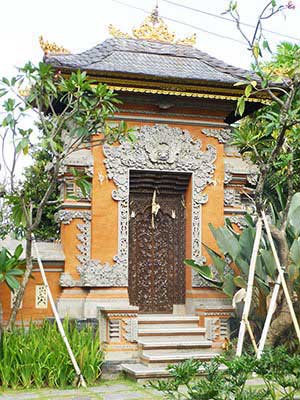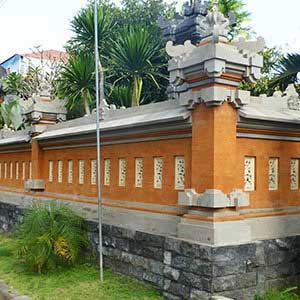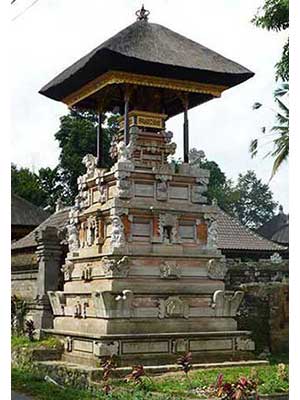Balinese Architecture Gateways and Doorways
Basic Principles of Balinese Architecture - Gateways, Walls and Materials
Following on from our previous articles about Balinese building and temple design we look at how Balinese architectural elements are used in gateways, walls and kul kul towers.
We also consider the type of materials that are traditionally used in Balinese building construction.
See also:
- Balinese Architecture and Building Design Part 1 - Layout and Spiritual Background
- Balinese Architecture and Building Design Part 2 - Principles of Building Design

In parts 1 and 2 we have been considering the requirement for a building permit (IMB) that buildings in Bali incorporate elements of Balinese style in their design. We have talked about Balinese architecture in terms of layout and building design.
There are of course other structures that surround property including gateways, walls, kul kul towers, temples and bales. As with building design these structures are also designed according to Tri Angga with raised foundations, a middle "body" section and overhanging roofs. While the degree of decoration varies enormously the general principles remain the same.
Balinese Gateways
As the point of entry to a builidng, gateways are very important and are designed to allow passage while deterring malevolent spirits from entering. Balinese gateways come in a myriad of designs but have common elements. As with other Balinese buildings gateways have a stereobate on which the structure is built. There are steps up to the raised threshold (so passage is above the stereobate, the Nista portion of the structure) which then fall again on the inside. The walls are the body or Madya portion of the gateway and consist of 2 columns usually bridged across at the top. These columns often have small alcoves for offerings. A Balinese style roof forms the upper Utama portion of the gateway to protect it.
The doorway itself is closed off by a traditional two leaved Balinese door which is often decorated with carved wood panels and, in more sumptuous situations, gilded or painted.
Directly behind the gateway and inside the compound there is often a small screen wall (aling aling) so when you enter you pass through the door and have to change direction to walk around the screen wall. This is to deter evil spirits from entering.

On traditional house compounds the entrance gate is, wherever possible, placed towards the Kelod (seaward) end of the Kauh (sunset) side of the compound. This is because the gateway is the place where malevolent spirits my try to enter and this is the "impure" corner of the compound. If this is not possible then screen walls may be used to guide people from the gate towards the kelod/kauh corner of the compound before entering the compound proper.
Balinese Walls
Walls follow similar principles with a thick base structure (Nista) along the bottom, a middle portion (Madya) thinner than the base and a broader coping along the top to protect the wall below.
Some walls and gateways may be quite simple in their design while others, particularly temple walls and gateways, can be very ornate both in construction and in decoration.
You may notice that many temple gateways have a leering monster carved over the doorway. With bulging eyes, sharp teeth and hands on each side this is Bhoma the protector whose role is to scare away evil influences.
Balinese Kul Kul Tower

Another structure you may often see is a kul kul tower, this is a raised structure on which a kul kul is mounted. The kul kul is a wooden drum made from a hollowed out log which is struck with a stick to call the village together. Kul kul towers are very common in temples and are often heavily decorated. You will also find them in other places such as banjars or administration buildings. While such a structure may seem unnecessary in a domestic house you may find them built as decorative water towers or as a security post or even a small office.
Materials Used In Balinese Architecture
Balinese architecture makes extensive use of natural materials for external finishing.
Stone
A range of stone is available in Bali from dark volcanic stone often used for temples and flooring, grey paras stone used for walls and steps, sandstone which is quite soft and used for wall cladding, very soft white palimanan stone (like a hard chalk) which is used for floors and wall cladding. Palimanan is popular amongst those who like that pure white greek temple look but has several problems being very easy to stain (that rather palatable merlot may be seen for many years to come after Aunt Dotty had one or two too many) and being very soft to the extent that wall panels have a tendency to fall off the walls.
Then of course there is marble which is used for all sorts of purposes but mostly for wall and floor surfaces. Indonesia has an extensive range of quality marble which is exported all over the world. It is far lower in cost here than abroad.
Wood
In bali wood is extensively used in building for support columns, beams, roof structures, roof facia boards windows and doors.
Hardwoods such as teak, merbau and ulin are popular though they are becoming increasing difficult to get and prices are rising dramatically. Bingkirai is now often used for window and door frames on modern buildings but has a downside in that it tends to expand and shrink as the moisture content varies. Coconut wood is now commonly used particularly for roof frames, it is hard and quite heavy.
Walls and roofs are often finished with fired clay particularly terracotta for roof tiles and red bricks for wall cladding.
The Balinese use some very clever techniques in their use of red brick. In many walls you will find the bricks have been rubbed together using water as a grinding medium so the bricks are a very close fit - no mortar joints. Bricks are also ground into a powder and used for finishing or as a decorative coating.
All across the island you will find Balinese buildings externally clad with red brick with grey stone used for inlays and decorative features on walls and columns. The grey siltstone is paras stone and tends to be quite soft making it easy to carve allowing the Balinese to express their amazing creativity and artistic skill.
Decoration Of Balinese Buildings
Wherever you go in Bali you will yourself surrounded by carvings. Buildings are often extensively decorated with traditional designs carved into wood and stone in walls doors windows columns and beams. The designs may be anything from simple floral motifs to elaborate representations of mystical figures that have important significance for the Balinese people.
By including Balinese carvings in your buildings you are helping to keep the traditional carving skills alive and helping to maintain what is probably one of the most important aspects of Balinese culture.
Building in stages
Many Balinese houses are often a work in progress. Initial basic structures may be built so they can be lived in then later as money comes available stone and brick wall cladding may be added and at the last stage carving of wood and stone may be added. This is why you will often see paras stone panels and wall inlays that are roughly shaped but left blank, the carving may or may not be added at a later stage when money or the carver is available.
Family compounds can never be considered complete, buildings may be added as the family grows or demolished and rebuilt as wealth or status increases.
Summary - How we can incorporate Balinese architecture in our buildings
Finally we can summarise a number of ways that we can satisfy IMB requirements and incorporate elements of Balinese architectural style within our building design.
- Have a balinese style roof, usually but not always hipped and with a slope of 30 to 45 degrees. The roof may or may not be flared at the lower edge and roof ornaments are preferred.
- Buildings to be built on a stereobate or raised floor which protrudes outside the wall line but not outside the roof line.
- Walls with visible square support columns at corners and along walls. Walls should not be too high to keep them in proportion to the rest of the building.
- Incorporation of two leaved wooden doors and windows at the main entrance.
- Use traditional materials on external surfaces such as terracotta, red fired clay brick, stone and wood, for roofs use terracotta tiles, alang alang, bamboo or wood shingles.
- Incorporate Balinese carvings on wood and stone elements.
- A traditional Balinese gate (this does not have to be the main entrance)
- The outer wall with a thick foundation, topped by a coping that protects the wall beneath and supporting columns along the wall.
- A temple to the gods at the corner of the land nearest Mt Agung.
This provides some very basic guidelines in what is a complex subject. For further guidance it is a good idea to consult your local holy man.
See also:
- Balinese Architecture and Building Design Part 1 - Layout and Spiritual Background
- Balinese Architecture and Building Design Part 2 - Principles of Building Design
Copyright © Phil Wilson 2014
This article or any part of it cannot be copied or reproduced without permission from the copyright owner.
